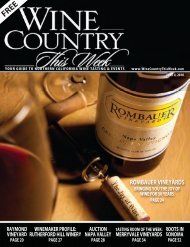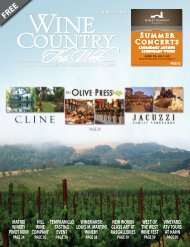View As PDF - Wine Country This Week
View As PDF - Wine Country This Week
View As PDF - Wine Country This Week
- No tags were found...
You also want an ePaper? Increase the reach of your titles
YUMPU automatically turns print PDFs into web optimized ePapers that Google loves.
BY JOSH STEINTo oak or not to oak? So many decisions.Driving through wine country right now, asharvest is reaching its peak, gives your nose just asmany interesting things as your eyes. One of myfavorite post-workday joys is cruising past wineriesat night with the top down, smelling thefermentations sweetly giving way to wines ready forbarrels. Or not. I also enjoy that the decisionsbeing made about so many thousands andthousands of gallons of wine aren’t mine to make aswhen the grapes come in, those winemakers have tomake decisions about oak usage and logistics almostfrom the start, and there are lots of choices awaiting.For whites, the decisions come down to thedegree, if any, of oak influence. Many white varietiesdo not benefit from oak exposure, and even neutralbarrels (barrels used long enough that oak tannin is no longerperceptible in wines stored therein) can cause a stylistic miscue sincebarrels play host to Oenococcus oeni, the bacteria responsible formalic-to-lactic acid conversion. Unless extraordinary and expensiveprecautions are taken, most winemakers would combine separate lotsof filtered oaked and unoaked whites to arrive at a blend with thedesired level of oak influence rather than hoping to arrive at an idealmiddle through chance in the barrel.Red wines, though, present a bit of a different set of options. Oakis useful throughout the production process, so some folks will beusing toasted or untoasted oak shavings at the crusher to alleviate anyunderripe “green” aromatics or flavor compounds frommethoxypyrazines, which contribute cigar or tobacco at low levelsand green pepper or grassy, herb-y notes at higherlevels. <strong>Wine</strong>makers can ferment in barrels either byremoving the heads and punching down intoupright barrels or through reassembling the barrelsand using a rotation system to keep the cap wet byspinning. They can use larger puncheons to givemore subtle, “rounder” notes to the wine withoutgiving as “oaky” a presence – liquid volume tosurface area matters a lot.Post-pressing, most reds are aged either in barrelor in tanks with some kind of oak adjunct inserted;as with barrel options so go the aduncts:winemakers have choices that range from oak source(American, French, Hungarian and beyond), to toastlevel, to toasted or untoasted heads in barrels, and aslew of options for creating oak effects sans barrels including “beans,”cubes, spirals, blocks, sticks-in-chains to fit into barrel bungholes andstaves of various shapes and sizes for tank inserts. Think back toyour first visit to a big toystore as a kid; now picture an adult kid andyou know how winemakers feel about their oak options. It’s great tohave choices, but there are lots of decisions to make.Photo courtesy of DelDotto VineyardsJosh Stein has been in the Napa wine business for a decade, and, in addition to being owner/winemaker of the Stein Family <strong>Wine</strong> Group, which produces a nationally and internationally distributedportfolio of wine brands and donates 5% of its sales to the children of wineworkers in the form of collegescholarships and support funds, he regularly consults for wineries and organizations throughout the NorthBay and Coast via their subsidiary, Discrete <strong>Wine</strong> Support Services. With the other hours of his life, heteaches all levels of developmental writing, college composition and American Literature at Fairfield’sSolano College.12Follow us on twitter @<strong>Wine</strong><strong>Country</strong>tW
















